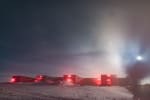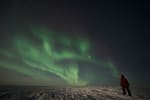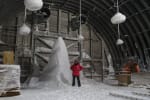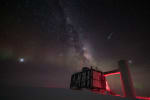Observations made by the IceCube Neutrino Observatory at the Amundsen–Scott South Pole Station and confirmed by telescopes around the globe and in Earth’s orbit have for the first time provided evidence for a known blazar as a source of high-energy neutrinos. These results are presented in two papers published this week in the journal Science. […]
Week 26 at the Pole
The 4th of July is now behind us, but this view of the South Pole station continues with the red, white, and blue theme, while the other side of the station just shows the blue sky and the white snow. These image were only possible due to a bright moon, bright enough to illuminate the tracks in the snow surface. […]
Week 25 at the Pole
The recent stretch of bad weather finally broke, showing off some nice auroras. Here, you can make out a bright spot in the sky, which is Mars, soon to reach its closest approach to Earth in many years. […]
Week 24 at the Pole
Midwinter is approaching, so the winterovers got together for a group photo that they’ll use to send out traditional greetings to other stations. Looks like a bunch of happy campers. […]
Week 23 at the Pole
Nice snow drift! Or sastruga, as one might say at the Pole. This enormous snow structure appeared inside the logistics arch, which is a large unheated storage facility, pushed through to the inside through closed doors. That is one strong wind (or one leaky door). […]
Week 22 at the Pole
Since it’s nighttime all the time during winter at the South Pole, it can be pretty dark outside, depending on the weather. But with clear conditions, you can get a wondrous night sky. Here we have the IceCube Lab under quite the starry sky, with the Milky Way in clear view and an Iridium flare making a noticeable mark. […]
IceCube at Neutrino 2018
The 2018 IceCube delegation at the Neutrino conference includes 22 researchers presenting 20 posters and two plenary talks. […]
Week 21 at the Pole
Last time it was frosted glasses, now it’s a frosty staircase. Blowing snow during the recent storms has left its mark on the staircase and platforms of the IceCube Lab (ICL). At some point, that snow will need to be removed—but that’s for another day. […]
Week 20 at the Pole
The winds kept at it last week. The blowing snow not only obstructs the view when trying to take photos, but it makes it tricky to see the flags that mark your way in this dangerously cold landscape. The weather did clear at one point, though, long enough to capture some amazing shots of the Milky Way. […]
Week 19 at the Pole
A quiet week at the Pole for the detector, but he photos were just striking! Here we have a nice shot of the ceremonial pole marker, with a bright moon situated just behind the sphere and flags flapping in the wind. […]









